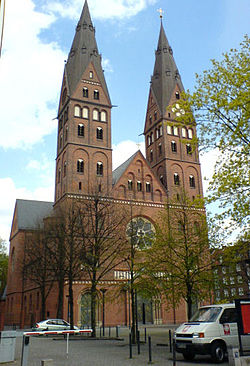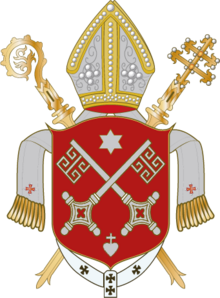This article needs additional citations for verification .(May 2016) |
Archdiocese of Hamburg Archidioecesis Hamburgensis Erzbistum Hamburg | |
|---|---|
 Cathedral of Our Lady, Hamburg | |
 | |
| Location | |
| Country | Germany |
| Ecclesiastical province | Hamburg |
| Deaneries | 17 |
| Statistics | |
| Area | 32,493 km2 (12,546 sq mi) |
Population
|
|
| Information | |
| Denomination | Catholic Church |
| Sui iuris church | Latin Church |
| Rite | Roman Rite |
| Established | 23 July 1973 (As Apostolic Administration of Schwerin) 24 October 1994 (As Archdiocese of Hamburg) |
| Cathedral | Cathedral of Our Lady, Hamburg |
| Patron saint | St Ansgar |
| Current leadership | |
| Pope | Francis |
| Archbishop | Stefan Heße |
| Suffragans | Diocese of Hildesheim Diocese of Osnabrück |
| Auxiliary Bishops | Rev. Msgr. Horst Eberlein (Auxiliary Bishop-elect; Titular Bishop-elect of Tisedi; appointed by Pope Francis Feb. 9 '17) |
| Vicar General | Rev. Ansgar Thim |
| Map | |
 | |
| Website | |
| erzbistum-hamburg.de | |
The Archdiocese of Hamburg (Lat. Archidioecesis Hamburgensis; Ger. Erzbistum Hamburg) is a Latin Church ecclesiastical territory or diocese of the Catholic Church in the north of Germany and covers the Federal States of Hamburg and Schleswig-Holstein as well as the Mecklenburgian part of the Federal State of Mecklenburg-Vorpommern. In terms of surface area it is the largest in Germany. It is characterized by its situation as a diocese in the Diaspora. Seat of the archbishop is the New St. Mary's Cathedral in Sankt Georg, Hamburg. On January 26, 2015 Stefan Heße, Generalvikar of the Archdiocese of Cologne, was appointed Archbishop of Hamburg. [1]